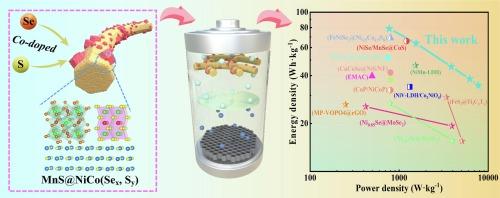缺陷调节MnS@Ni0.654Co0.155Se1.234S0.101结构:一种解锁超级电容器储能潜力的新方法。
IF 9.7
1区 化学
Q1 CHEMISTRY, PHYSICAL
引用次数: 0
摘要
过渡金属硫化物(tms)由于具有较高的理论容量和多样的反应机理,在储能领域具有巨大的应用潜力。然而,超级电容器的性能限制来自于各种固有缺陷,包括活性材料利用率低和电导率不稳定导致的循环稳定性差。为了解决这些问题,本文将硒原子加入到硫化物中,旨在利用硒的高导电性来增强过渡金属硫化物的电活性。这种方法提高了硫化物的导电性和离子传输速率,提高了结构的稳定性。此外,金属有机骨架(MOF)的分层多孔结构被协同优化以增强复合材料的储能能力。所得MnS@NiCoSeS-1复合材料表现出优异的电化学性能,在三电极结构下,在1 a g-1下,比容量达到901.0 C g-1,在3 a g-1下循环10,000次后,容量保持率为82.6%。此外,由该复合材料构建的混合超级电容器(HSC)在功率密度为775.2 W kg-1时具有78.85 Wh kg-1的高比能。这些发现验证了共掺杂策略在优化活性材料利用率方面的有效性,并为高能量和功率密度超级电容器的设计提供了新的见解。本文章由计算机程序翻译,如有差异,请以英文原文为准。

Defect-regulated MnS@Ni0.654Co0.155Se1.234S0.101 structures: A novel approach to unlock energy storage potential in supercapacitors
Transition metal sulfides (TMSs) have significant potential in energy storage applications due to their high theoretical capacity and diverse reaction mechanisms. However, performance limitations in supercapacitors arise from various intrinsic defects, including low active material utilization and poor cycling stability caused by unstable electrical conductivity. To address these issues, this paper incorporates selenium atoms into sulfides, aiming to leverage selenium’s high conductivity to enhance the electroactivity of transition metal sulfides. This approach improves both the conductivity of sulfides and the ion transport rate as well as enhances structural stability. Furthermore, a hierarchically porous structure of metal–organic framework (MOF) is synergistically optimized to augment the composite’s energy storage capacity. The resulting MnS@NiCoSeS-1 composite demonstrates excellent electrochemical performance, achieving a specific capacity of 901.0 C g−1 at 1 A g−1 in a three-electrode configuration, with a capacity retention of 82.6 % after 10,000 cycles at 3 A g−1. Additionally, the hybrid supercapacitor (HSC) constructed from this composite exhibits a high specific energy of 78.85 Wh kg−1 at a power density of 775.2 W kg−1. These findings validate the effectiveness of co-doping strategies for optimizing active material utilization and provide novel insights into the design of supercapacitors with both high energy and power densities.
求助全文
通过发布文献求助,成功后即可免费获取论文全文。
去求助
来源期刊
CiteScore
16.10
自引率
7.10%
发文量
2568
审稿时长
2 months
期刊介绍:
The Journal of Colloid and Interface Science publishes original research findings on the fundamental principles of colloid and interface science, as well as innovative applications in various fields. The criteria for publication include impact, quality, novelty, and originality.
Emphasis:
The journal emphasizes fundamental scientific innovation within the following categories:
A.Colloidal Materials and Nanomaterials
B.Soft Colloidal and Self-Assembly Systems
C.Adsorption, Catalysis, and Electrochemistry
D.Interfacial Processes, Capillarity, and Wetting
E.Biomaterials and Nanomedicine
F.Energy Conversion and Storage, and Environmental Technologies

 求助内容:
求助内容: 应助结果提醒方式:
应助结果提醒方式:


